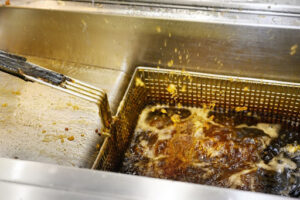Running a restaurant or any food service business is a fast-paced, never-ending cycle. The kitchen stays busy, orders keep coming in, and something always needs attention. With so much going on, it’s easy to overlook things that aren’t right in front of you — like your grease trap.
That hidden tank under the sink or out behind the building plays a huge role in keeping your kitchen running. It catches fats, oils, and grease (FOG) before they clog up your drains or back up into the sanitary sewer system. But if you don’t clean it often enough, you’re looking at slow drains, nasty odors, and even potential fines.
So, how often should a grease trap be cleaned? Let’s break down everything you need to know about grease trap cleaning frequency and why sticking to a regular cleaning schedule is important.
What Is a Grease Trap and How Does It Work?
A grease trap is designed to catch fat, oil, and grease before they enter the sanitary sewer system. When cooking oil, food scraps, and grease wash down the sink, they can solidify and create blockages in your pipes. The grease trap intercepts these materials, allowing cleaner water to flow into the sewage system.
Over time, FOG builds up in the trap, and if it’s not cleaned out regularly, it can cause backups, slow drainage, and even damage to the wastewater system. That’s why sticking to a proper cleaning schedule is so important.
How Often a Grease Trap Should Be Cleaned
So, how often should a grease trap be cleaned? There’s no one-size-fits-all answer here, but it’s generally recommended to clean a grease trap at least every one to three months. Some businesses may need it even more often, depending on how much grease and food waste go down the drain daily.
Here are some factors that can affect grease trap cleaning frequency:
Size of Your Grease Trap
Larger grease traps hold more waste and don’t fill up as fast, meaning they might need less frequent cleaning. On the other hand, smaller traps reach capacity quicker and require more attention.
Volume of Cooking and Food Waste
A busy kitchen that fries food all day will generate a lot more grease than a small café that mostly serves sandwiches. If your kitchen produces high amounts of cooking oil and food debris, you’ll need to schedule grease trap cleaning more often.
Local Regulations
Many cities have strict rules on how often a grease trap should be cleaned. Some areas require monthly cleanings, while others have specific grease trap maintenance logs that must be kept up to date.
Odors and Drainage Issues
If you’re noticing foul smells near the sink or slow-draining water, this can be a sign that your grease trap is overdue for a cleaning. Don’t wait until it gets worse — acting fast can save you from costly repairs.
What Happens If You Don’t Clean Your Grease Trap?
Neglecting grease trap maintenance doesn’t just lead to annoying plumbing issues. It can create serious risks for your business, customers, and even the environment.
Drain and Sewer Blockages
Grease builds up over time, eventually clogging the pipes and causing backups in sinks, dishwashers, and even toilets. If it makes it into the main sewer line, it can lead to costly emergency plumbing services.
Health and Safety Hazards
A full grease trap becomes a breeding ground for bacteria, creating health hazards in your kitchen. The lingering grease can also attract pests, making it harder to keep a clean, sanitary work environment.
Foul Odors
That awful smell creeping through your kitchen or dining area? It could be coming from an overdue grease trap. As food waste and grease sit and rot, they produce a strong, unpleasant odor that can turn customers away.
Environmental Pollution
If grease overflows into the sanitary sewer system, it can end up in local water sources, leading to pollution. Many cities require businesses to follow strict grease disposal guidelines to protect the natural environment.
Expensive Fines and Repairs
Many local health departments issue fines for grease trap violations. If an overflow or backup occurs, you might have to pay for major plumbing work to fix the problem. Regular maintenance is a small price compared to these potential costs.
How Grease Trap Cleaning Works
Professional grease trap cleaning typically involves removing all grease, oil, and solid waste from the trap using a vacuum truck. The trap is then scrubbed and inspected for any signs of damage. Some companies, like A&J Sewer Service, also offer cooking oil collection in Chicago to help businesses recycle used cooking oil safely.
A clean grease trap helps keep your kitchen running smoothly while staying compliant with local regulations.
Schedule Your Grease Trap Cleaning in Chicagoland
Staying on top of grease trap maintenance is one of the best things you can do to keep your kitchen running efficiently. If you’re wondering how often a grease trap should be cleaned, the answer depends on your kitchen’s needs — but regular cleanings every one to three months are highly recommended.
As you can see, understanding the right grease trap cleaning frequency for your business can save you from plumbing headaches. If you’re due for a cleaning and need professional grease trap services in Chicago, IL, or one of the surrounding areas, A&J Sewer Service is here to assist you. Our team specializes in grease trap cleaning, cooking oil collection, and more to keep your kitchen safe and compliant. Schedule your service today!



